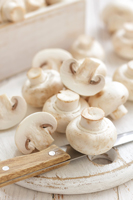There are about 350 species of thyme. Since they readily hybridize (blend with other species) in cultivation, their classification is quite complex. Many produce good garden plants, which are easy to grow and exhibit fragrant foliage and small pink or lilac flowers. Although the flowers are small, they’re numerous and produce copious amounts of bee-pleasing nectar. Some of the finest-flavored honey comes from thyme plants.
Thyme plants are perennials, belong to the mint family, and exist in various shapes and colors. They can be erect and bushy—reaching 18 inches in height—or creeping and spreading, growing about three inches high. The flowers vary from white to mauve, lilac, magenta, blue-violet, and pale pink. Leaf colors vary from light green to olive grey-green, golden green, dark green, silver, or bronze-tinted.
Exotic Names
All these differences give rise to a variety of exotic names for the various cultivars such as Golden King, Silver Queen, Archer’s Gold, Rainbow
Falls, Pink Ripple, Goldstream, Lemon Curd, Silver Posie, and Highland Cream. The leaves boast unique aromas providing a variety of scents such as pine, camphor, caraway, lemon, orange, tangerine, celery, or eucalyptus. These aromas and flavors are the result of subtle differences in the terpenoid composition of the essential oil they contain.
Thyme plants represent one of the most fragrant and pleasant greenerys that can grace your garden. Their small size makes them ideally suited for crevices in paving, rock gardens, and containers. They can thrive in stony or rocky situations and love plenty of sunshine. Thyme can be used in the garden to deter beetles and other cabbage pests. For healthier growth, it’s important to trim them after flowering and remove dead blossoms. Sprigs can be picked during the growing season and used fresh or dried.
Dinner Thyme
The most commonly used varieties for culinary purposes are the common thyme (Thymus vulgaris) and lemon thyme (T. citriodorus). Common medicinal plants include Spanish thyme (T. zygis), and creeping thyme (T. serpyllum). They’re all native to southern Europe and Western Asia, but are now cultivated commercially in many parts of the world. Much of the commercial thyme comes from Spain, which boasts 37 varieties.
The fresh or dried leaves as well as the flowering tops are widely used to flavor soups, stews, in baked or sautéed vegetables, casseroles, and custards. Thyme provides a warm tangy flavor—somewhat like camphor—and can retain its taste in slowly cooked dishes. The herb is also used in marinades (especially for olives), and stuffing. The leaves find use in potpourri and moth-repellent sachets.
The essential oil of thyme not only flavors foods, but can be added to soaps, toothpastes, cosmetics, perfumes, and antiseptic ointments. The oil is used in aromatherapy to relieve pain and elevate mood. In addition, it may have a calming effect in stress-related conditions. Thyme baths have been used to help relieve aches and joint pains.
Therapy Thyme
Thyme contains an essential oil that is rich in thymol, a powerful antiseptic, antibacterial, and a strong antioxidant. When used in mouthwashes, it helps treat inflammations of the mouth and throat infections. That’s why it’s a common component of cough drops.
Because of its essential oil, thyme possesses expectorant and bronchial antispasmodic properties, making it useful in the treatment of acute and chronic bronchitis, whooping cough, and inflammation of the upper respiratory tract. Thyme enhances the action of the cilia in the bronchi and directly acts on the bronchial mucosa. The terpenoids are responsible for the expectorant activity, while a variety of flavonoids are responsible for the spasmolytic effect of thyme on the bronchioles.
All the members of the mint family, including thyme, possess terpenoids, which are recognized for their cancer-preventive properties. Rosmarinic and ursolic acids are major terpenoids in thyme that possess anti-cancer properties.
Tea Thyme
A tea can be made by adding one teaspoon of crushed thyme in a half cup of boiling water, letting it steep for 10 minutes, and then straining. This tea can be drunk three to four times a day for the treatment of coughs and may be sweetened with honey, which also acts as a demulcent, thereby increasing the tea’s effectiveness.
Thyme is entirely safe to use and has no reported side effects. However, its essential oil may be irritating to the skin and mucous membranes, causing an allergic reaction in some. Certain varieties produce a stronger reaction than others. Medicinal doses of thyme and especially thyme oil are not recommended during pregnancy, as they can act as a uterine stimulant.
Winston J. Craig, Ph.D., R.D., is professor of nutrition at Andrews University, Berrien Springs, Michigan.



